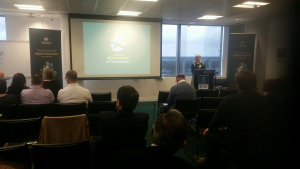A new emerging technology is receiving quite a bit of publicity of late, that technology is called ‘blockchain’. Discussions on blockchain do appear vague and theoretical at this stage, due to the newness of the concept. It is however touted as a new secure internet based method of exchanging value.
Still in it’s infancy, the best way to describe the technology is as follows.
What is Blockchain?
Blockchain technology is basically a secure decentralised database that is a public register of assets and transactions in blocks of data. These blocks of data are single views of the truth in what can be described as an open ledger. As transactions occur, additional blocks of data are linked together to form the so-called block-chain. Transaction history is thus locked up in the linked blocks of data thereby creating an everlasting record of all the transactions across the blockchain network.

As a bit of background, we have always ‘traded’ and used some middle-man to enforce, facilitate or verify a ‘trade’, such as a bank or a marketplace. Blockchain technology means that traditional ‘middle-men’ are not needed to transact business. So it is likely that the disruption to the banks and the banking system will be the most obvious point of evolution of the technology. Bank to bank international settlements are an obvious opportunity for blockchain technology with one international bank quoted as saying that the technology could save $20billion per year to the world’s banks within 6years. Bitcoin, the digital currency, is an example of the use of blockchain technology, but there remain limited examples of it’s practical application currently.

The cost savings, efficiency improvements, speed, plus security profile are the big pluses of the blockchain technology.
There are many projects out there looking at using ‘blockchain’ including the banks, the ASX, CSIRO, Start-Ups and the Federal Government.
So why are the banks getting involved in this new technology when it will impact them so much, potentially adversely in terms of fee revenue? They clearly want to get on the ‘front-foot’ and be early adopters of blockchain before somebody else comes in and disrupts them. Even now, there are already ‘fintech’ peer-to-peer offerings on the web whereby currency is exchanged without bank involvement, such as CurrencyFair. The banks want to stay one step ahead of any long-term threats and blockchain is their big weapon and also greatest threat in one.
What will become of currency and banks in the future?
What will become of cash in the future?
What will become of paper-based transaction processes?
The internet and technology are rapidly evolving so rapidly and it’s impact on the way we live and transact and do business can only but change along with it.
SUMMARY
The likely impact of blockchain is expected to be substantial but its impact remains some years off. So be aware what blockchain technology is, but as sure as the sun will rise, the practical application of the technology will extend far beyond what is envisaged so far.
Ross – Billson Advisory






